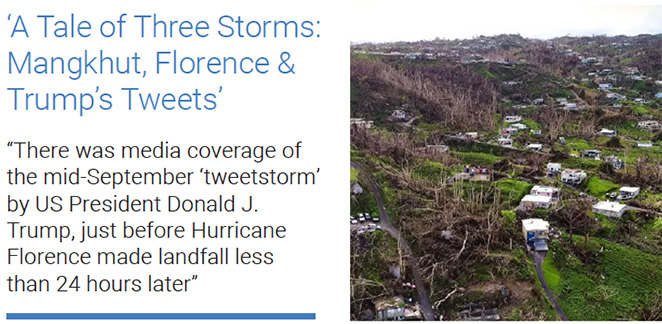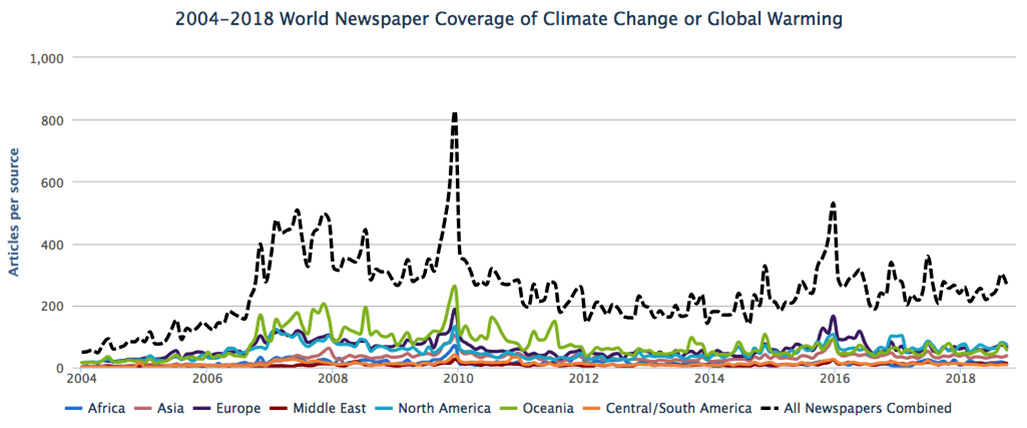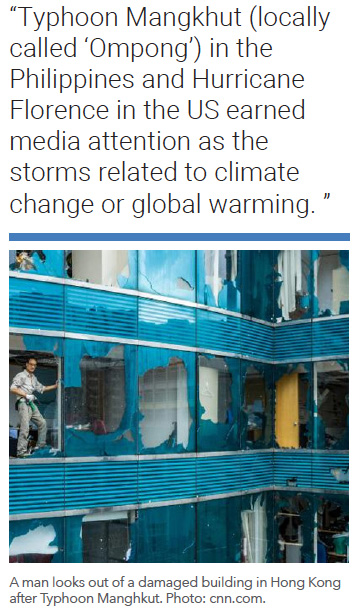Monthly Summaries
Issue 21, September 2018
[DOI]

Yabucoa, Puerto Rico, still reeling from Hurricane Maria.
September was a busy month for media attention to climate change and global warming. However, coverage across the globe decreased 8.5% from the previous month of August 2018, and was also down slightly (2%) from September last year. An increase was most pronounced in Asia (up 15%) and the Middle East (up 15%) in September.Elsewhere, decreases were detected in North America (down 8%), Oceania (down 39%), Central/South America (down 3%), Africa (down 36%) and Europe (down 9%) compared to the previous month of August.
In January of this year, MeCCO expanded coverage to sixty-two newspaper sources, six radio sources and six television sources. These span across thirty-eight countries, in English, Spanish, German and Portuguese. In addition to English-language searches of “climate change” or “global warming”, we search Spanish-language sources through the terms "cambio climático" or "calentamiento global", German-language sources through the terms ‘klimawandel’ or ‘globale erwärmung’, and Portuguese-language sources through the terms "mudanças climáticas" or "aquecimento global". Figure 1 shows these ebbs and flows in newspaper media coverage at the global scale – organized into seven geographical regions around the world – over the past 177 months (from January 2004 through September 2018).

Figure 1. Newspaper media coverage of climate change or global warming in sixty-two sources across thirty-five countries in seven different regions around the world, from January 2004 through September 2018.
Considerable attention was paid to political content of coverage during the month of September, as signs of a ‘Trump Dump’ returned in the US (where media attention that would have focused on other climate-related events and issues instead was placed on Trump-related actions (leaving many other stories untold)). For example, media attention was paid to Trump Administration announcements of rollbacks on regulations on methane emissions from oil and gas production. Journalist Timothy Puko from The Wall Street Journal reported on the proposed rollback of Obama-era climate rules, “moving to ease requirements for oil and gas companies that were designed to limit leaks of the heat-trapping gas methane”. Journalist Coral Davenport from The New York Times observed “The new rules follow two regulatory rollbacks this year that, taken together, represent the foundation of the United States’ effort to rein in global warming. In July, the EPA proposed weakening a rule on carbon dioxide pollution from vehicle tailpipes. And in August, the agency proposed replacing the rule on carbon dioxide pollution from coal-fired power plants with a weaker one that would allow far more global-warming emissions to flow unchecked from the nation’s smokestacks”. The Washington Post journalist Juliet Eilperin reported that “in the fourth rollback of a major federal climate rule in less than two months, the Interior Department eased requirements Tuesday that oil and gas firms operating on federal and tribal land capture the release of methane, a potent greenhouse gas. Officials said that the rule, adopted in 2016, was duplicative, given state laws, and imposed too heavy a burden on the private sector. Environmentalists and Democrats vowed to fight the reversal in court, saying that it would lead to greater air pollution and boost emissions linked to climate change. The 2016 regulation required operators to capture methane leaks, install more modern controls and develop a plan to reduce the release of the heat-trapping gas, which, for the first 20 years after being released into the atmosphere, is roughly 86 times more powerful than carbon dioxide. The new rule largely eliminates those requirements, including limits on how much methane can be released and burned off. Experts said the previous standards would have prevented the release of nearly 180,000 tons of methane into the atmosphere each year…According to Interior’s analysis, the reduction in compliance costs would outweigh the royalties taxpayers would otherwise have received on the captured oil and gas, for a net saving of $734 million to $1.01 billion over a decade”.
There was media coverage of the mid-September ‘tweetstorm’ by US President Donald J. Trump, just before Hurricane Florence made landfall less than 24 hours later. Figure 2 shows particularly notable tweets during this September 13 storm. The Washington Post journalists Philip Rucker, Robert Costa and Josh Dawsey wrote, “As Hurricane Florence churned toward the Carolinas, President Trump on Thursday diverted attention from the government’s preparations for the monster storm to his personal grievances over last year’s Hurricane Maria by falsely claiming a conspiracy to inflate the death toll in Puerto Rico. Trump drew immediate rebukes from Democrats as well as some Republicans for denying a sweeping study, which was accepted by Puerto Rican authorities”.

Figure 2. @realDonaldTrump tweets in mid-September like these above were picked up in many media accounts of hurricane and typhoon activity.
At the subnational level the Global Climate Action Summit hosted by Governor Jerry Brown also garnered attention in media accounts. Journalist James Rainey from NBC News reported, “Seeking to cement California's reputation as a global leader in combatting climate change, Gov. Jerry Brown on Monday signed two measures designed to push the state to 100 percent renewable electricity and so-called carbon neutrality by 2045. Senate Bill 100 raises the state’s already ambitious goals for producing electricity from wind, solar and other green sources. The aim is to ensure greenhouse gas emissions are low enough that they can be absorbed by forests, oceans, soil and other natural systems…Brown...also issued an executive order pushing the state to reduce its net output of greenhouse gases into the atmosphere — including from the single largest source, cars and trucks — to zero by the same 2045 deadline. Meeting the 100 percent carbon-neutral goal in just 27 years and potentially becoming “net negative” on carbon, gives California the most ambitious such target of any government in the world, the governor’s office said”. Reporter Liam Dillon from the Los Angeles Times called this “the latest in a series of ambitious goals set by the state to combat the effects of climate change”.
Media accounts also focused on scientific dimensions of climate change and global warming during the month of September. For example, journalist Chris Mooney from The Washington Post covered how research teams from the Center for Research and Advanced Studies at the National Polytechnic Institute in Mexico and the University of Alaska Fairbanks were working to understand how methane releases from freshwater lakes contribute to global warming.
Also this month, relating to the political ‘tweetstorm’ and other items, there was significant coverage crossing ecological and meteorological themes. For example, Typhoon Mangkhut (locally called ‘Ompong’) in the Philippines and Hurricane Florence in the US earned media attention as the storms related to climate change or global warming. On September 14, journalists Bard Wilkinson and James Masters from CNN reported “The Philippines is evacuating thousands of people, deploying soldiers and positioning emergency provisions as Super Typhoon Mangkhut threatens more than four million people in the north of the country. Mangkhut -- stronger than Hurricane Florence, which is currently lashing the US East Coast -- is expected to make landfall on the Philippines island of Luzon island early on Saturday. Current wind speeds are up to 285 kilometers per hour (180 mph). The massive storm, the equivalent of a Category 5 hurricane, has prompted alerts across east and southeast Asia”. Meanwhile, on September 16, The Washington Post journalist Katee Zezima reported that “tropical depression Florence continued its march through the Carolinas on Sunday, dumping torrential and historic amounts of rain. Floodwaters are expected to push many rivers to all-time highs and could spur life-threatening landslides as the storm’s remnants move into the mountains in the middle of the states and then up into southwestern Virginia”.
 Covering Typhoon Mangkhut on September 17, The Guardian journalists Carmela Fonbuena and Hannah Ellis-Petersen reported that “at least 34 bodies have been recovered and another 30 people are still missing after a landslide caused by Typhoon Mangkhut buried a miners’ bunkhouse in the Philippines where dozens of people had taken shelter. The landslide struck a remote town in Itogon in the mountain province of Benguet, about 125 miles north of Manila. Benguet was one of the worst affected areas after a category five typhoon swept through the Philippine region of Luzon on Saturday, wreaking destruction on homes and crops, and causing massive flooding”. On September 18, The New York Times journalist Hannah Beech reported that “Typhoon Mangkhut churned the rich earth of the Cordilleras, and floods of mud inundated mining bunkhouses and mountain homes…all told in the Philippines, more than 100 people are thought to have perished as a result of Mangkhut, the strongest storm the world has seen this year”.
Covering Typhoon Mangkhut on September 17, The Guardian journalists Carmela Fonbuena and Hannah Ellis-Petersen reported that “at least 34 bodies have been recovered and another 30 people are still missing after a landslide caused by Typhoon Mangkhut buried a miners’ bunkhouse in the Philippines where dozens of people had taken shelter. The landslide struck a remote town in Itogon in the mountain province of Benguet, about 125 miles north of Manila. Benguet was one of the worst affected areas after a category five typhoon swept through the Philippine region of Luzon on Saturday, wreaking destruction on homes and crops, and causing massive flooding”. On September 18, The New York Times journalist Hannah Beech reported that “Typhoon Mangkhut churned the rich earth of the Cordilleras, and floods of mud inundated mining bunkhouses and mountain homes…all told in the Philippines, more than 100 people are thought to have perished as a result of Mangkhut, the strongest storm the world has seen this year”.
Meanwhile, covering Hurricane Florence on September 18, Associated Press journalist Claire Galofaro reported that “the storm has claimed more than 30 lives and an untold number of homes on its slow march across North Carolina, inundating city after city: Wilmington, New Bern, Lumberton. Now authorities are warning that by the time the Cape Fear River in Cumberland County crests Tuesday at 62 feet (19 meters) — 27 feet (8 meters) over its flood stage — it will threaten to swamp anything within a mile on either side of it. Its tributary, the Little River, is expected to flood, too. More than 7,000 people were ordered to evacuate by Sunday afternoon. But many, weary of a storm that’s lingered on and on, did their own rough calculus of the odds and decided to stay”. That same day, The Washington Post journalists Patrick Sullivan, Rachel Siegel, Mark Berman and Joel Achenbach reported that “the death toll from Hurricane Florence rose Monday to 32, and the misery in the Carolinas might be many days from cresting. The historic storm has disrupted life for millions of people, and the surging floodwaters have spawned an environmental calamity across a vast region pocked with manure ponds and coal ash pits”. Meanwhile, The Wall Street Journal journalists Valerie Bauerlein and Russell Gold reported that some of the coal-ash (a byproduct of burning coal for energy) from a Duke Energy-owned landfill washed into a nearby lake. They wrote, “Part of the earthen top of the 20-foot tall landfill was gone, exposing the deep gray ash beneath, and an undetermined amount of the coal ash washed into nearby Lake Sutton, which feeds into the Cape Fear River”.
In the aftermath of Hurricane Florence – and intersecting with cultural themes – journalists Adam Gabbott and Oliver Laughland from The Guardian explored impacts through the lens of climate justice in a piece entitled, ‘In North Carolina, It’s the Poorest Who Bear the Brunt of Flooding’. They wrote, “Greenleaf [North Carolina] is home to national civil rights leader the Rev William Barber, who left the city briefly to evacuate his elderly mother. On the phone, Barber argued that Florence should mark a moment to discuss the state’s various forms of structural racism and economic inequality…Barber held nothing back. “The storms are not going to stop coming,” he said. “We are in the path of hurricanes. And the more this climate warms, the stronger the winds are going to get, the more erratic the storms are going to get. We’re going to get pummeled over and over again”. Also in the aftermath of the storm, journalist Michael Biesecker from the Associate Press reported that “Duke Energy activated a high-level emergency alert at a retired coal-fired power plant in North Carolina as floodwaters from the nearby Cape Fear River overtopped an earthen dike there and inundated a large lake, raising concerns of a potential breach”. On September 24, CBS News reported that the death toll had risen to 42 people. The piece also noted, “rivers swelling with the floodwaters of former Hurricane Florence are threatening to swamp communities near the South Carolina coast, leaving thousands ready to evacuate. More than a week after Florence crashed into the Carolinas, dumping heavy rains, all that water is nearing the coast. Authorities in Georgetown County, South Carolina, said they have put as many as 8,000 people on alert for possible evacuations starting Monday in expectation of a "record event" of up to 10 foot floodwaters this week”. Meanwhile, stories from Asia covered the aftermath of Typhoon Mangkhut. For example, journalists Jeanette Andrade and Melvin Gascon from The Philippines Daily Inquirer wrote about differential impacts on storm surges and crop damages.
Across the globe in September, there were a range of stories that intersected with the cultural arena. For example, coverage in early September included news of a burgeoning protest movement in Germany against coal mine development. Energy company RWE faced human resistance in the Hambach forest as they sought to develop the land for lignite strip mining. Surrounding activities at the Global Climate Action Forum in San Francisco, news stories emerged on mobilizations of support for climate action. For examples, Elaine Ganley and Chris den Hond in Paris and Christopher Weber in Los Angeles reported, “more than 18,000 people marched Saturday in Paris as part of an international mobilization to show popular support for urgent measures to combat climate change in advance of a San Francisco summit. Crowds overflowed a plaza in front of City Hall before marching east to the Place de la Republique, carrying an urgent message that it’s up to the public to put global warming at the top of the political agenda.” NBC journalist Kiki Intarasuwan reported, “Thousands of activists marched Saturday morning in San Francisco in what organizers call "the largest climate march the West Coast has ever seen" to demand action against climate change from elected officials. Supporters with "Rise for Climate, Jobs & Justice" walked from Embarcadero Plaza on Market Street to Civic Center where organizers held a rally with resource centers and music”. Meanwhile, journalist Matt MaGrath from BBC reported on an assessment of city-level engagement with climate mitigation actions in the face of country inaction. He wrote, “Twenty-seven cities, including Warsaw, Barcelona and Sydney, saw CO2 peak in 2012 and then go into decline… Emissions declined by 2% every year on average, while their economies expanded by 3% annually”. And journalist Brad Plumer from The New York Times reflected on the Summit, commenting that “there was no shortage of announcements at the meeting. Cities like Tokyo, Rotterdam and West Hollywood signed joint pledges to only buy zero-emissions buses after 2025. Companies like Walmart and Unilever rolled out new programs to limit deforestation in their huge supply chains. Dozens of philanthropic groups committed $4 billion over the next five years to fight climate change. But it will take time to tell whether these local actions can scale up quickly enough to make a significant dent in global emissions. And scientists are warning that time is short if we want to avoid the worst effects of climate change”.
As summer gives way to Autumn in the Northern Hemisphere, we at the Media and Climate Change Observatory will continue to track media attention to climate change, amid competing interests in other political, social, environmental, economic, and cultural issues around the globe.
